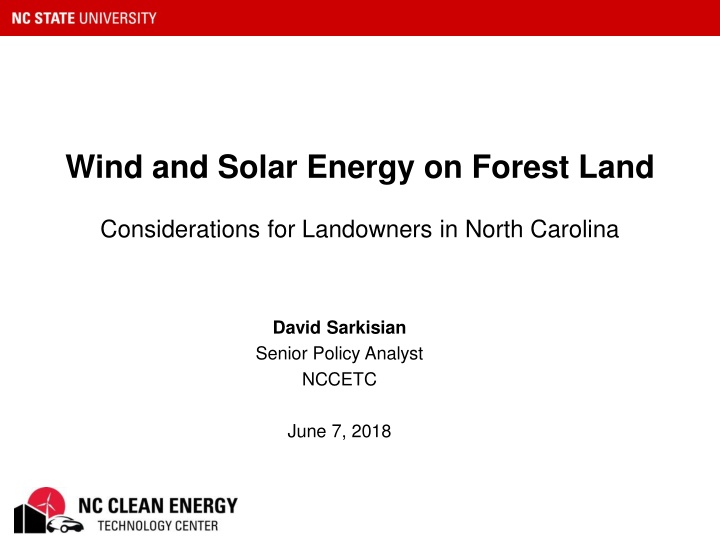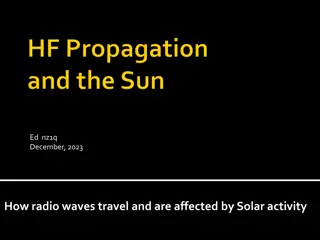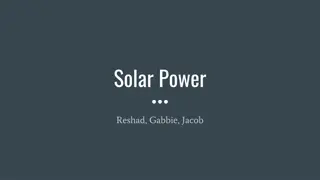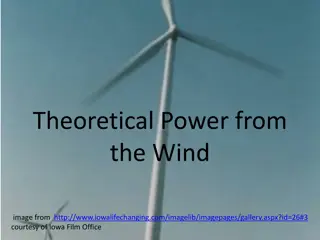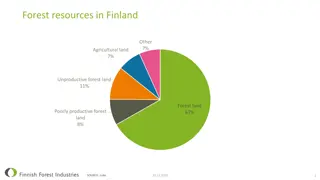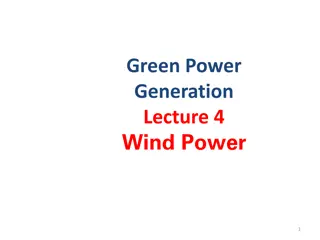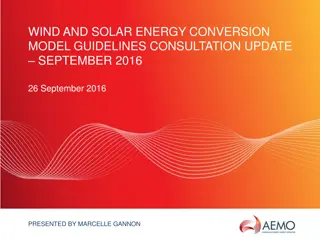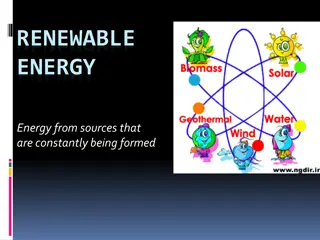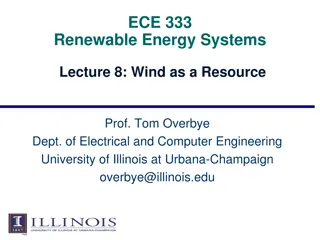Wind and Solar Energy Considerations for Forest Land in North Carolina
Exploring the potential of wind and solar energy on forested land in North Carolina, this article discusses the benefits and challenges of harnessing renewable energy in forested areas. Topics include the evolution of wind energy technology in forested regions, advantages, disadvantages, and the importance of accurate wind pattern modeling for successful energy generation projects.
Download Presentation

Please find below an Image/Link to download the presentation.
The content on the website is provided AS IS for your information and personal use only. It may not be sold, licensed, or shared on other websites without obtaining consent from the author.If you encounter any issues during the download, it is possible that the publisher has removed the file from their server.
You are allowed to download the files provided on this website for personal or commercial use, subject to the condition that they are used lawfully. All files are the property of their respective owners.
The content on the website is provided AS IS for your information and personal use only. It may not be sold, licensed, or shared on other websites without obtaining consent from the author.
E N D
Presentation Transcript
Wind and Solar Energy on Forest Land Considerations for Landowners in North Carolina David Sarkisian Senior Policy Analyst NCCETC June 7, 2018
About the NC Clean Energy Technology Center UNC System-chartered Public Service Center administered by the College of Engineering at North Carolina State University Mission is to advance a sustainable energy economy by educating, demonstrating and providing support for clean energy technologies practices, and policies Objective research, analysis, & technical assistance Manages the Database of State Incentives for Renewables and Efficiency (DSIRE www.dsireusa.org)
Wind Energy in Forested Areas In the past, reduced wind speed caused by tree cover made wind development in forests difficult Most US wind development in open central plains areas
Wind Energy in Forested Areas Technological advances including larger and taller turbines have made forest wind more productive Many projects in Northern Europe (Germany, Sweden, Denmark, United Kingdom) These countries are heavily forested Land outside forest areas is relatively scarce and expensive First wind project on U.S. Forest Service-managed land began operation in 2017, in Vermont
Pros and Cons of Locating Wind Energy in Forests Advantages Reduces impacts on humans (noise, flicker, aesthetic disturbance) Simultaneous use possible Land relatively inexpensive Disadvantages Reduced energy production Need to remove some trees Impacts on forest ecosystems
Wind Pattern Modeling Wind speed and patterns are vital for wind energy generation Extremely important to accurately determine the wind patterns for a site before undertaking project Sophisticated modeling techniques enable this to be done, but inaccuracy is a risk
Wind Pattern Modeling Roughness Mapping Engineers obtain measurements of tree height and size from airborne scans Modeling techniques are used to determine wind patterns base on input from the scans Newer techniques are reducing risk of error
Steps in Development of a Wind Project Site selection Site needs adequate wind speed (generally at least 5 m/s or 11 mph) and access to transmission lines Requires initial access to land to conduct meteorological studies Land acquisition Land use agreements generally for 20 to 50 years Developers usually lease rather than purchase land Land leases will be for many acres, but actual space used is much smaller (Avangrid leased 22,000 acres but actual footprint around 200 acres)
Steps in Development of a Wind Project Permitting Need permits at all levels of government Local: zoning, local ordinances State: application and review process led by NCDEQ Federal: FAA, DoD, FWS
Steps in Development of a Wind Project Construction Roads are built for construction vehicles Concrete foundations and grid infrastructure built along with turbine tower Decommissioning Removal of equipment, and possibly roads and revegetation depending on agreement Lifespan of turbines is 20-25 years, but leases can be longer if turbines are repowered
Economics of Wind Energy Land Leases Leases are generally per-turbine or per-megawatt; payment rates around $3,000-$4,000 per-megawatt per- year Leases may include royalty payments based on electricity production Base lease rate may be lower Some risk taken by landowner in this case Before turbines are constructed, developers sign option leases with landowners to enable study of area Can commit landowner to allow construction $2 to $10 per acre (for whole area, not just footprint)
Economics of Wind Energy in Forested Areas Not necessary to remove all trees in area; roughly 1 hectare (2.47 acres) cleared around a turbine Wind speeds (and energy production) tend to increase when more trees are removed This effect is not large enough to make removal of additional trees worthwhile Assumes timber income is being earned regardless Wind speed could affect decisions on what trees to plant, how often to harvest, etc.
Economics of Wind Energy in Forested Areas Property Tax Issue If land is converted to a commercial use, classification of land for property tax may change Property taxes are deferred three years for agricultural land (including timber) in NC to be based on present use value When land is developed, deferral is rolled back, and taxes immediately become payable Applies to land area where the turbine is located; other area remains agricultural
Wind Energy Market in North Carolina North Carolina has relatively little wind energy development The projects that have been built (Avangrid/Amazon) or are under consideration (Apex/Timbermill) are located in the northeastern part of North Carolina This area is part of PJM Interconnection, which allows wind facilities to sell directly to industrial customers In other areas of the state, wind generation would need to sell to/through utilities
Environmental Effects of Wind Energy in Forest Areas Tree Removal Some trees must be removed to make space for turbine construction as well as access roads Carbon payback time assuming 1 hectare is cleared is less than 1 year (Enevoldsen, 2017) Habitat Disruption Building and operation of turbines can disrupt habitats for wildlife (Lopucki et al, 2017) Roads can also disrupt wildlife habitat (as with any land use requiring access roads) (Wildlife Society, 2007)
Environmental, cont. Bird and Bat Mortality Wind turbines can present hazards for birds and bats that fly at the level where the turbines spin (NWCC, 2010) New technology has sought to reduce these hazards (May et al, 2015) Considered by state DEQ and federal FWS when deciding on permits
Environmental, cont. Noise (Michaud et al, 2016) Shadow Flicker (Voicescu et al, 2016) Aesthetic/Landscape Disruption (Klaeboe and Sundfor, 2016) State law requires 0.5 mile setback from adjacent property owners; local ordinances can be higher
Property Value Effects Generally, studies have found that wind turbines do not have significant effects on the value of neighboring properties Most studies have focused on residential land, which is more likely to be negatively affected Study based in Pennsylvania found no effect on agricultural land values (Shulz et al, 2015) Wind development can increase property tax revenues for local communities
North Carolina Wind Energy Permitting North Carolina passed a law (HB 484) created a permitting process for wind energy projects in 2013 The state Department of Environmental Quality leads the permitting process, can deny permit if project would have adverse impact on: Military operations or training Ecosystems, natural resources, or historic sites Fish or wildlife Views from high-value recreational areas (national or state parks Navigation in coastal waters
North Carolina Wind Energy Permitting Decommissioning Requirements The 2013 law (HB 484) requires wind energy developers to ensure that sufficient funds are available for decommissioning even if the developer becomes insolvent NCDEQ places specific decommissioning requirements for individual facilities in their permit conditions
North Carolina Mountain Ridge Protection Act 1983 law prevents (amended 2009) prevents construction of wind turbines taller than 100 feet on ridges at elevation of 3,000 feet or greater Limits wind development in mountainous western N.C.
Federal Wind Permitting Wind projects need approval from several federal agencies depending on circumstances Federal Aviation Administration (FAA): always need approval if turbines higher than 199 feet Department of Defense (DoD): review triggered when FAA approval sought; applies if project is within military training routes or special use airspace Fish and Wildlife Service (FWS): permits needed if project could affect migratory birds or endangered species
Federal Wind Permitting Other agencies that can be involved include: EPA: if water pollution is an issue Army Corps of Engineers: If dredge/fill permit needed US Forest Service: if on national forest land Bureau of Land Management: if on other US public lands
Federal Production Tax Credit for Wind Energy Wind projects constructed through 2019 are eligible for a tax credit based on electricity production. Tax credit is gradually phasing down Projects that begin construction in 2018 receive 1.44 c/kWh Projects beginning in 2019 receive 0.96 c/kWh Credit not available for projects beginning in 2020 or later
NC Wind Moratorium There is currently a moratorium on new wind projects in North Carolina Scheduled to end December 31, 2018 Motivated by concerns about conflicts with military aviation training
Solar Energy on Forest Land Solar development on forest land requires that trees be removed No dual use with timber, unlike wind (some agricultural dual uses are possible) Solar farm areas smaller than wind farm areas for same capacity
Solar Energy on Forest Land - Economics Solar developers typically pay between $750 and $1,400 per acre per year for land leases Comparable to wind lease rates considering amount of space used
Solar Energy in North Carolina Policy Changes Solar development in N.C. has been associated with PURPA contracts HB 589, passed in 2017, changes PURPA process for large-scale solar Payment for solar electricity now based on competitively- bid contracts
Solar Policy Changes Tax Credits The federal Investment Tax Credit for solar will gradually phase down Stays at 30% through 2019 Afterwards drops to 26% in 2020, 22% in 2021, and 10% in 2022 North Carolina no longer has a tax credit for solar energy Credit ended in 2015 Property tax exemption for solar still in effect
Solar on Forest Land Environmental Effects Removing trees to construct solar panels will on net reduce carbon dioxide emissions (Turney and Fthenakis, 2011) Assumes the electricity being replaced comes from fossil fuel generation Emission reduction is large even with tree removal
Solar on Forest Land Environmental Effects Other environmental impacts of solar development on forest land can include: Habitat Disruption Soil Compaction Herbicide Use
Thank you! Contact Information: David Sarkisian Senior Policy Analyst North Carolina Clean Energy Technology Center dpsarkis@ncsu.edu (919) 513-4790
